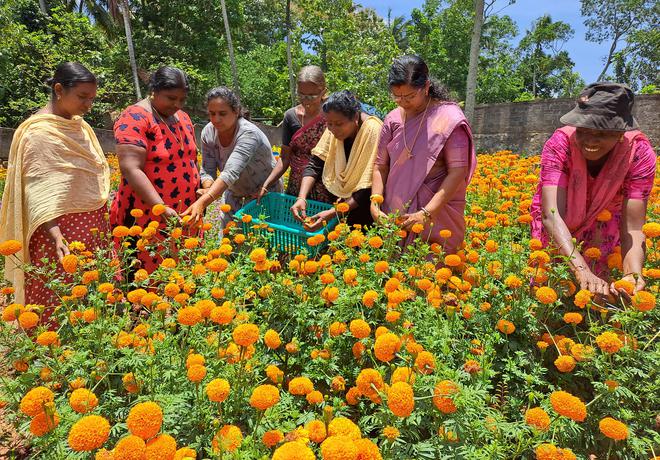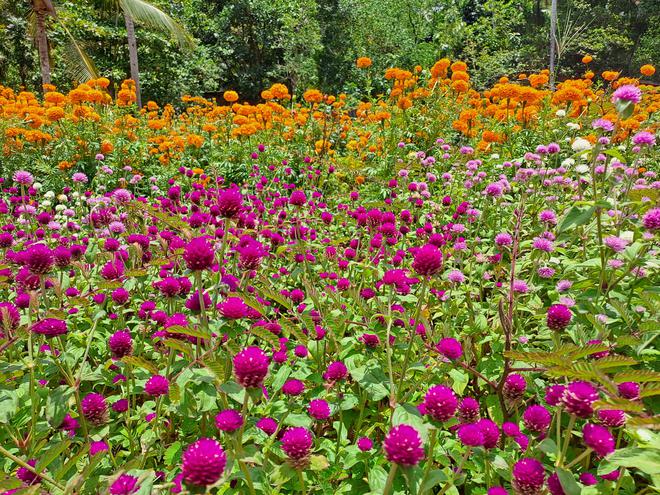Balaramapuram, about 20 km from the Kerala capital of Thiruvananthapuram, is known for its off-white handloom saris with golden borders. This Onam though, it is not the cloth alone that is making Balaramapuram proud.
Just out of Balaramapuram, at Nellivila, is a nondescript gate behind which shines a crop of yellow and orange marigolds interspersed with globe amaranth in white, pink, and purple.
This is Panayarakunnu ward in Balaramapuram grama panchayat of Nemom block in Thiruvananthapuram district. Here, flowers are being cultivated on 2 acres with an eye on the Onam market.
Onam is synonymous with elaborate pookkalams (flower carpets) arranged in homes, schools and colleges, offices, residents’ associations, and open spaces. A large quantity of the flowers required for the pookkalams every year come from neighbouring States. Kerala, though, has been trying to promote flower cultivation so that farmers in the State benefit from the huge spike in demand for Onam.

Kudumbashree, the State’s poverty eradication and women empowerment mission, hopes to benefit during this season. The mission, launched in 1998 against the backdrop of the People’s Plan movement that was an exercise in decentralisation of power a couple of years before, celebrated its silver anniversary this year.
In these 25 years, Kudumbashree’s activities have evolved from thrift and credit to entrepreneurship, community mobilisation, rural development, and social development. With over 45 lakh women as members, it has given Kerala a sizeable chunk of its local body leaders too.
Under the National Rural Livelihoods Mission, agriculture is yet another sector where Kudumbashree has increased women’s presence through groups that are given loans for farming. These groups called joint liability groups (JLGs) and have been involved in vegetable, tuber, and paddy cultivation since 2011.
Over the past two years, the JLGs have expanded their footprint into floriculture, particularly to tap into the demand for flowers during the Onam festival period.
This year, the JLGs are cultivating flowers such as marigold, chrysanthemum, jasmine, globe amaranth, and lotus in all districts with the support of local self-governments.

This year the area under Onam season flower cultivation has increased from 128 acres last year to 780.03 acres. In addition, there are 1,819 JLGs now involved in the growing and selling of flowers, against 534 last year.
Flower power
At Panayarakunnu in Balaramapuram grama panchayat, marigolds and globe amaranth are being cultivated under the leadership of Beena K. of the award-winning Pournami JLG.
“We had grown marigold on 50 cents last year, and encouraged by the results decided to expand cultivation to a larger area this time around,” says Beena.
Ward member N. Valsalakumari who is the force behind Pournami’s success procured hybrid marigold seeds from Bengaluru in Karnataka, and used the globe amaranth seeds she already had, spending some of her own money and some of the JLGs funds. She is also at hand to guide all of Pournami’s decisions, be it farming, marketing, or networking.
The first harvest is serious business, with Kudumbashree’s local office-bearers and panchayats everywhere trying to rope in ministers and MLAs for the inauguration. The State’s Minister for Food and Civil Supplies G.R. Anil graced the harvest of flowers at Panayarakunnu on August 10.

Reetha J., chairperson of Kudumbashree’s Balaramapuram community development society (the CDS is at the top of the Kudumbashree’s three-tier structure starting from neighbourhood up to panchayat/ municipal level), points out that nearly 4.5 acres in the panchayat is under flower cultivation, but Pournami has the maximum area of them all.
“Flower cultivation was launched keeping in mind the Onam festival as part of Santhoshagramam, a pilot project for which the Kerala Institute of Local Administration had selected Balaramapuram grama panchayat,” says Balaramapuram panchayat president V. Mohanan.
Both Mohanan and Valsalakumari, however, recognise that that flower crop will be enough only to meet the demand from within the panchayat, and sales outside it are unlikely.
In Nemom block of the district itself, Pallichal grama panchayat that comes under the Kattakada Assembly constituency that kicked off flower cultivation last year as part of the ‘Nammude Onam, Nammude Pookal’ (Our Onam, our flowers) initiative of I.B. Satheesh, MLA, has flowers growing on 26 acres this year.
The maximum cultivation is being done on five acres in Kurandivila ward by two Kudumbashree JLGs, Harithasree and Vanithasree. A board proclaiming Kurandivila the Thovala of Pallichal greets visitors here. Thovala in Tamil Nadu is from where the bulk of the flowers reach markets in Thiruvananthapuram district.
Women’s hour
Selvanesan, a veteran farmer who is guiding the JLG women with the cultivation, says the harvest yields nearly 100 kg of flowers. “It even went up to 125 kg once. But the flower size will keep reducing as more harvests are done.”
Word has reached wholesalers too, with traders from the Chala market in Thiruvananthapuram city reaching Kurandivila every few days to buy the flowers. The flowers are also sold at Kudumbashree’s Onam fairs, held across the State, says Pushkala S., a Kudumbashree CDS member.
It is not just customers looking for a good deal who reach Kurandivila. “Families and young people are flocking here to take photos and selfies among the flowers,” says Pushkala.
Seeing better profit in flowers than the usual Onam vegetables, Kudumbashree JLGs in many parts of Thiruvananthapuram district such as Varkala, Athiyanoor, Perumkadavila, Parassala, and Vellanad blocks have shifted to growing Onam flowers. In all, 63 JLGs are growing marigold, golden amaranth, and lotus on 67.15 acres in the district.
Districts such as Alappuzha, Thrissur, Malappuram, and Palakkad have even more area than Thiruvananthapuram as part of Kudumbashree’s flower cultivation. In Alappuzha, the success achieved last year has led to an increase in the scale of cultivation, says Sreepriya R., district programme manager, Farm Livelihood, Kudumbashree, Alappuzha.
Last year, 294 JLGs in seven blocks in the district grew flowers on 27.8 acres. The yield was 1.56 lakh kg. An enthused Kudumbashree district mission drew up a project to grow flowers on at least 25 cents in each CDS this year. “All rural panchayats except those under the Veliyanad block panchayat are growing flowers for the Onam market. We told the CDS in places such as Kavalam and Mattur that face constant waterlogging to contribute in whatever manner they could,” says Sreepriya.
A whopping 797 JLGs are now cultivating marigolds, chrysanthemum, and globe amaranth on 114.08 acres in the district.
One of these is Lakshmi JLG, led by Maya V.V. in Mararikulam North grama panchayat. Vegetable growers for the past four years, they have made their first foray into growing flowers on a portion of 2.5 acres farmed by them. The six-member group planted 400 marigold saplings, harvested the flowers three times, and sold them at a relative’s shop. “From the initial ₹60 a kg, the price has climbed to ₹100 now. We are told it may even go up to ₹150 a kg the closer it gets to Thiruvonam day,” says Maya.
There are some newbies too on the scene. A recently formed JLG, also named Lekshmi, in ward 5 of Cheruthana panchayat in the district, was taken by the idea of growing flowers for the first time. They planted 720 marigold saplings on 30 cents and harvested five kg of flowers. “Saplings were distributed in all wards, but our flowers have turned out really well. We received a good price too: ₹100 for a kg of marigolds,” says Sandhya T., one of its five members.
In Palakkad district, flower cultivation is marked by small parcels of land, but adds up to 88.7 acres. Up to 35 JLGs are involved in floriculture in 17 panchayats, up from 14 acres in eight panchayats last year, says Mohamed Noushad K.A., district programme manager, Farm Livelihood, Palakkad.
P.R. Saraswathy leads Kadhali, a five-women JLG in Varani ward of Malampuzha grama panchayat. They sold their first harvest of 20 kg of marigolds, from 25 cents, for ₹40 a kg, but have since started selling flowers for pookalams for nearly ₹100 a kg. Though experienced hands at farming, Kadhali’s first foray into floriculture came with its share of mistakes such as planting only orange marigolds and sowing the seeds directly into the ground.
Ponmani, a four-member JLG led by Geetha, that is cultivating marigolds on 50 cents at Thalayinakkadu in Sreekrishnapuram grama panchayat, too experienced problems with seeds and ended up purchasing saplings. More challenges came their way when a nearby field flooded, and water overflowed into theirs. They also had to find ways to keep pigs and peacocks at bay. It has been worthwhile though, with multiple harvests, and a good price of more than ₹170 a kg for the flowers.
Erratic weather patterns have been a challenge for the JLGs. If rain initially did their crop no good, lack of it too is a problem, says Geetha. “It is only a few days ago that we received the showers after long. Watering plants using a pump every evening is not the same as summer rain.”
Pricing issues
For some JLGs, market prices have been a downer. “Market rates strangely never seem to go up. Even now, we are told to sell them flowers at ₹40 a kg,” rues Saraswathy. But is their first foray likely to be their last? “We are farmers. We may burn our fingers but do not quit,” says Saraswathy.
That is a thought echoed by quite a few JLGs such as Lekshmi, while others say they will only take a decision after all the flowers are sold and profits calculated. A few JLGs such as Pournami are contemplating round-the-year floriculture by diversifying, but even they are unsure how profitable it will be.
Pallichal panchayat president T. Mallika says that may be difficult for individual JLGs, unless the panchayat, Kudumbashree, Krishi Bhavan, all come together to make it happen.
I.B. Satheesh, Kattakada MLA, voices concern about Kudumbashree’s role getting limited to maintenance of the crop and its marketing, instead of actual farming. “In Kattakada, we are promoting a model of convergence that goes beyond government departments to convergence of ideas and activities. As part of it, we want to get the JLGs to farmlands and earn profits, and will implement a project for this.”
Land availability remains a problem for the JLGs. Though the scheme guidelines stipulate a minimum of an acre for farming, most of the leased land is available in small parcels. Landowners may not have sustained interest or expect a share of the profits.
Satheesh says the panchayat can give notice to landowners if fallow land is left idle for three years. Or it can help the Kudumbashree in getting a lease once land is identified.
Kudumbashree executive director Jafar Malik says more often than not, an agreement is arrived with land owners on profit sharing at the time of signing the lease itself. So far, the model has been successful. Also, the JLGs have three lakh members so if they are determined, flower production can be increased substantially.







